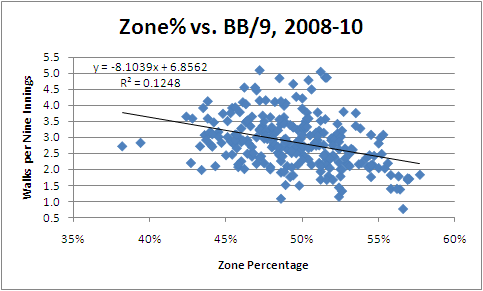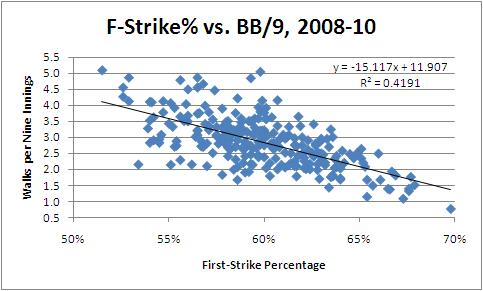What’s Wrong with Edinson Volquez?
The One Night Only game previews for this weekend will appear at 3pm ET. In the meantime, what follows concerns one of the starters for today’s only afternoon game — Edinson Volquez of the Cincinnati Reds (who play in Chicago at 2:20pm ET).
As any member of his eponymous support group will tell you, Cincinnati Red starter Edinson Volquez is an enigma.
On the one hand, the 27-year-old features a fastball that sits at about 94 mph, a whiff-making changeup, the ability to induce grounders at above-average rates, and an overall swinging-strike percentage that generally places among the league’s best. (The 11.6 SwStr% he presently sports is eighth-highest out of 113 qualified pitchers.)
On the other hand, there are glaring — almost tragic — flaws. Reds fans and Volquez’s fantasy owners are likely acquainted with the righty’s first-inning struggles this season. Whether the product of randomness or something more specific than that, Volquez has been miserable in the first, allowing more than twice as many runs in that inning (14 total thus far) than in all the 27.1 frames he’s pitched in innings two through six combined (just six runs allowed). His defense-independent stats back this up: Volquez has a FIP of about 13.90 in his six first innings compared to a ca. 4.10 FIP in all the other innings he’s pitched after the first.
As has been the case with other iterations of this “What’s Wrong with X?” series, much of what is haunting seemingly “broken” players in these early days of the 2011 season is bad luck. Nor is Volquez an exception to this. His 4.12 xFIP suggests that he’s pitching — if not excellently, per se — then at least decently. Much of the difference between his xFIP and 5.67 ERA is attributable to his home-run per fly-ball rate of 24.1%. That number, which is the worst in the league among qualified pitchers, is likely to regress toward Volquez’s career mark of 11.7% — probably even better than that, as the league’s HR/FB rate has dropped as a whole.
Beyond these most obvious factors, however, lies something a bit more mysterious — namely, the cause behind Volquez’s crazy walk rate, which stands at 6.48 BB/9 as of this morning. Our man Mike Podhorzer addressed Volquez’s walk rate in the middle of April, writing:
Of course, we all know what the issue is: Volquez sometimes seems to be pitching as if the plate was the size of an amoeba. It is frustrating to watch when this frequent occurrence happens, to say the least. Amazingly, coming into yesterday’s game, Volquez had thrown first pitch strikes 64.4% of the time, well above the league average of 58.9% and easily a career best. His Zone% of 46.3% is not too far below the 47.8% league average, so one wonders how he manages to walk so many batters. I would guess that on an overall basis, he does not throw the number of balls that would suggest such poor control. However, the walks are coming because Volquez loses focus or whatever and throws balls in bunches. This is just me speculating here and throwing out a possible explanation.
While I don’t necessarily possess the tools to go far beyond Podhorzer’s speculations, I thought it might be interesting to linger a bit longer on his (i.e. Volquez’s, not Podhorzer’s) plate-discipline numbers.
Anecdotally speaking, one might assume that Zone% (i.e. the amount of pitches inside a hypothetical strike zone) would correlate strongly with walk rate. As it turns out, one would be mostly wrong. In fact, Zone% doesn’t even go half way towards explaining walk rate.
Regard, data from 257 qualified pitchers, 2008-10:
As you can see, the angle of the slope is somewhat telling, but the data points are rather scattered on either side.
What correlates much more strongly to walk rate is first-strike percentage (F-Strike%). Here’s the data from that same sample of qualified pitchers:
Now, here’s the strange part: if we plug Volquez’s current first-strike rate of 56.9% into the equation you see there (the y = -15.117x + 11.907 one, I mean), we don’t get anything close to Volquez’s current walk rate of 6.48 BB/9. Rather, we get an expected walk rate 3.3 BB/9 — that is, about half.
Two other pitchers since 2008 have posted identical first-strike percentages to Volquez’s current rate — Ricky Romero in 2009 and Vicente Padilla in 2008 — yet they posted walk rates of “just” 3.99 BB/9 and 3.42 BB/9, respectively.
Why the difference?
Well, as Podhorzer suggests, it’s possible that event chaining has something to do with it. It is, indeed, possible that Volquez, for one reason or another, throws balls in bunches, which would give him more than the expected number of walks.
Another likely reason for the difference in walk rate between Volquez and his two counterparts actually has to do with one of Volquez’s strengths — namely, his ability to induce swings and misses. As mentioned above, Volquez has one of the better swinging-strike rates in the majors right now — a fact that has directly contributed to his excellent strikeout rate of 9.45 K/9. But it’s because he induces so many swings and misses that Volquez is likely to find himself getting deeper into counts.
In that 2009 season when they threw 56.9% first-pitch strikes, Romero and Padilla recorded swinging-strike rates of 9.6% and 8.2%, respectively — both above-average marks for starters, who generally sit somehwere around 8.0%, but still a pretty fair distance from the 11.6% mark Volquez is currently sporting. Because batters put the ball into play more often against Romero and Padilla, they (i.e. the batters) were less likely to make it into situations where they could walk. Batters who face Volquez, however, might actually find themselves whiffing their way into walk-friendly counts.
In terms of “fixing” Volquez, there’s no easy explanation. Regression should take care of the biggest part of “what’s wrong” with him in the form of fewer home runs per fly ball. Volquez’s walk rate is, however, a different proposition. It’s clear that he can miss bats, and, despite the best advice of Ron Gardenhire, one is reluctant to dissuade a pitcher from using his best stuff. Moreover, that line of thinking takes for granted that Volquez could throw more strikes if he tried. For one thing, Volquez has never shown plus control; for another, he’s still returning from Tommy John surgery, where control is the last thing to return.
If there’s one change that might benefit Volquez — although, I’d certainly stop short of calling it a suggestion proper — it might be a shift in pitch selection from more four-seam to more two-seam fastballs. Currently, per Pitch F/x, Volquez throws about 37% of the former and just 18% of the latter. Per Texas Leaguers, however, it’s the two-seamer that has a higher strike percentage (including a slightly higher whiff rate). Granted, those outcomes can change as pitch selection changes, but the difference in the two pitches is also likely slight enough that any real alterations would be minimized.
Carson Cistulli has published a book of aphorisms called Spirited Ejaculations of a New Enthusiast.



One of the better What’s Wron With” articles. I like how you brought in the F-Strike% and Zone% analysis along with providing a suggestion for improvement. Well done.